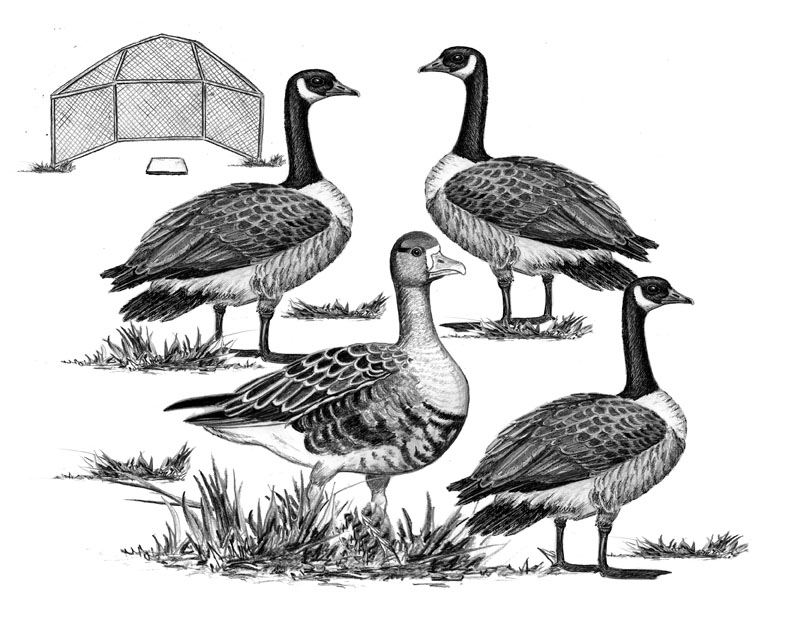
Dear Bird Folks,
I heard that a Greater White-fronted Goose was spotted at the old ball field in Provincetown. I drove up there, found the field and a flock of Canada Geese, but not the rare goose. Did I miss it? Is it still around? Any suggestions?
– Aimee, Kingston, MA
Here’s what I know, Aimee,
As I routinely point out, this column does not take place in real time, which makes it hard to report on current birds. By the time my response gets into the newspaper, the bird in question could have died from old age. But here’s what I know: On the second week in January, a birder by the name of “George” stopped into our shop to tell us he had found a Greater White-fronted Goose in Provincetown. Greater White-fronted Geese are rare birds on Cape Cod, so this was exciting news…well, exciting for birders. (BTW: George told me not to use his name, but I used it anyway. He’s not the boss of me.)
Found from England to Russia to Japan and several places in between, the Greater White-fronted Goose is one of the most widely distributed geese in the world (and one of the longest bird names I’ve ever had to type. Thank goodness for copy and paste). White-fronted Geese even have a population here in North America. They typically breed in Alaska and in Northern Canada, and spend the winter along the Gulf Coast and in California. During migration, they are also found in several Midwestern states, but are rarely seen in any state to the right of Indiana. (I’m talking about to the right geographically, not politically. Birds with such a wide global range tend to stay apolitical.) My slightly outdated copy of Birds of Massachusetts, reports that these birds are “vagrants” in the Bay State. While I suspect they have become slightly more regular in recent years, this is still a significant sighting. Good job, George (or whomever you’d like to be called). From a distance, Greater White-fronted Geese might be confused with Canada Geese. Both birds have plump brown bodies, but Canadas have black necks and black feet, while white-fronted geese have brown necks and bright orange feet. In addition, Canada Geese have their famous white cheek patch, while the “white front” on a white-fronted goose is a ring of white feathering around the bill and forehead. It basically looks like a goose that just finished a powdered sugar donut. As is the case with most geese, white-fronted geese pairs stay together for years. They also have a strong family bond. Most baby birds separate from their parents shortly after fledging, but young white-fronted geese may associate with the adults well into the following year. (It’s nice to know that at least some teenagers aren’t ashamed to be seen with their parents.)
The day after George tipped us off, Casey and Hannah raced up to see the bird, but I was working. For the rest of the week I had to listen to birders tell me about going to see the rare (around here) goose with the ridiculously long name. Finally, I had some time off and asked my wife if she’d like to take a ride to Provincetown. Thinking she was going to get lunch out of the deal (she wasn’t), she immediately agreed. Weather is a factor birders have to deal with anytime of year, but January is always full of surprises. As soon as we crossed the line into Truro we were greeted with a blast of ocean-effect snow. It wasn’t a total whiteout, but the wipers were on for the rest of the way. We parked at the Pilgrim Monument for free (one of the few good things about January) and from there I could scan the ball field below. The high location offered a good vantage point, but it was also painful as the snow blowing off the Atlantic stung the skin on my baby face. Speaking of babies, I turned to say something to my wife, only to discover that she was still sitting in the car…with the heat on. What a wimp! It looks like I was on this wild goose chase all by myself. Through my snow-speckled binoculars I could make out four Canada Geese on the distant baseball field. They were grazing in the area around deep shortstop. Like you, Aimee, I had driven all the way to Provincetown just to see four Canada Geese. Rats! Then I heard a muffled voice coming from the car. My wife was trying to tell me something, but with the windows closed I couldn’t understand a word. It was like having a conversation with the bubble boy. Finally, I got close enough to hear her say, “Check the bird on the right.” I wiped off my lenses, flipped up my binos and there it was. One of the Canada Geese turned out to be the lone Greater White-fronted Goose. My wimpy wife, while sitting inside the heated car, was able to spot the bird before I did. And lucky for me she did, because a second later the small flock took to the air and flew off. My wife’s sharp eyes saved the day and I gave her full credit…but not lunch.
Even though there’s a lag time between your question and my response, Aimee, I think you should take another trip to Provincetown. Often lost birds stay put for a while. Just be a bit more patient this time and study each and every Canada Goose you see, especially the ones around deep shortstop. You can even invite my wife. She’s really good at spotting birds, but just don’t say anything about lunch. That’s a sore subject.